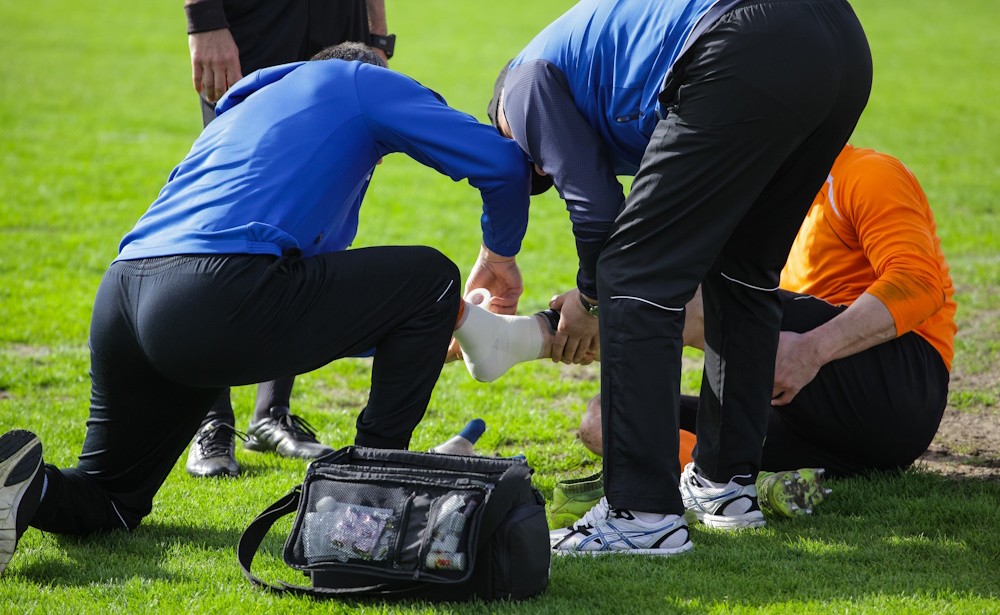How Orthopedic Doctors Tackle Injuries That Were Sustained On the Gridiron
Football is a demanding sport that combines speed, agility, and physical contact. This mix, while exciting to watch, increases the risk of on-field injuries. Statistically, football is responsible for more emergency room visits than any other sport.
Naturally, parents of student-athletes want to know, “What injuries pose the greatest risk to my child?”
Because football is a contact sport, no part of the musculoskeletal system is 100% safe. However, there are certain injuries that occur more frequently than others. By understanding these common football injuries and how they are treated, players, coaches, and parents can be better prepared for scenarios that require a visit to an orthopedic doctor.
This blog explores five frequent football injuries and how Wichita orthopedic doctors generally handle them.
Ankle Sprains
Ankle sprains occur when the ligaments that support the ankle stretch beyond their limits and tear. In football, this often happens during abrupt changes in direction, when landing from a jump, or from impacts during tackles.
How they’re treated: Orthopedic doctors typically have their patients follow the RICE protocol, which stands for rest, ice, compression, and elevation. During the initial phase, activities are limited to promote healing. Professional physical therapy has proven effective in restoring function, improving strength, and reducing the risk of recurrence. Severe sprains may require bracing or even surgery if the ligament damage is extensive.
Knee Injuries
Knee injuries are extremely common in football because most tackles are initiated below the waist. Hard twisting, pivoting, and sudden deceleration movements can also stress the knee joint, potentially resulting in ligament tears, such as ACL and MCL injuries, or meniscus tears.
How they’re treated: Although knee injuries are common, they are entirely unique to the patient. Treatment depends on the severity of the injury and the patient’s recovery goals. Mild knee injuries may only require rest and rehabilitation, while more severe tears could necessitate surgical intervention and extensive physical therapy.
To reduce the risk of sustaining a knee injury, parents and players should focus on preventative measures. Athletic training teaches strengthening exercises and the proper technique to use during play.
Bone Fractures
Bone fractures in football are usually the result of a direct hit or hard fall. Common sites for fractures include the legs, arms, ribs, and collarbone. As a preventative measure, players are encouraged to consider additional protective equipment beyond standard football pads. Ribcage protectors, for example, can reduce a player’s risk of sustaining fractured ribs.
How they’re treated: Most limb fractures are treated with immobilization, using a cast or splint, allowing the bone to heal undisturbed. More complicated fractures may require surgical procedures to properly align the bones or remove bone fragments. Recovery may also include physical therapy and rehabilitation to restore strength and mobility. Because orthopedic doctors specialize in the musculoskeletal system, they are equipped to diagnose and treat fractures occurring anywhere in the body, including the limbs, shoulders, hips, and torso.
Hamstring Strains
Hamstring strains are common due to the sprinting mechanics of football. The hamstring muscles, located at the back of the thigh, can be overstretched during high-speed movements or when making sudden changes in speed. Because of how much their position depends on speed, running backs, wide receivers, and cornerbacks are most at risk of sustaining hamstring strains.
How they’re treated: Treatment typically starts with rest, ice, and gentle stretching exercises. Compression sleeves have also proven to be beneficial. As recovery progresses, physical therapy can help with flexibility and strengthening. In rare cases, the patient may require the use of crutches if their injury makes it too painful to walk.
Concussions
Concussions are traumatic brain injuries that occur from impacts to the head, which are not uncommon in football due to the sport’s physical nature. Symptoms typically include headaches, confusion, dizziness, and memory problems.
How they’re treated: Although orthopedic doctors don’t typically treat concussions, they are medically trained in identifying them. The most critical aspect of concussion treatment is rest, both physical and cognitive. This means avoiding any activity that could exacerbate symptoms, including screen time and strenuous mental activities. Gradual return-to-play protocols should be followed under the medical supervision of a neurologist or sports medicine physician.
Signs It’s Time to Contact an Orthopedic Doctor
Football injuries are initially addressed by an athletic trainer or on-site physician. Typically, they will get the player off the field and perform some level of acute care to stabilize the injury. For example, they may apply a temporary splint to a bone fracture to secure things until they can get examined by their physician.
Contact an orthopedic doctor if your student-athlete is experiencing:
- Persistent pain
- Extreme swelling or bruising
- Limited range of motion
- Joint instability
- Numbness or tingling
- Inability to bear weight
- Visible deformity
How To Find the Best Orthopedic Doctor Near You In Wichita
The physical intensity of football makes it a thrilling sport, but also one where injuries are relatively common. Effective treatment and committing to preventive measures can help minimize the impact of these injuries, keeping players safer and ensuring that they spend more time on the field and less time recovering.
Parents of student-athletes are encouraged to explore the benefits of athletic training, as this form of physical conditioning can help reduce the risk of injury. For players who are trying to overcome pain from an injury, it’s advised to contact an orthopedic doctor to undergo a comprehensive exam.
Depending on the injury, an orthopedic doctor can run tests and perform diagnostic exams that get to the root cause of the issue. Then, the physician will develop a personalized treatment plan based on these findings. The other advantage of working with an orthopedic doctor is that they often collaborate with professional physical therapists, who are invaluable during the recovery process, creating a holistic approach to football injury recovery.

